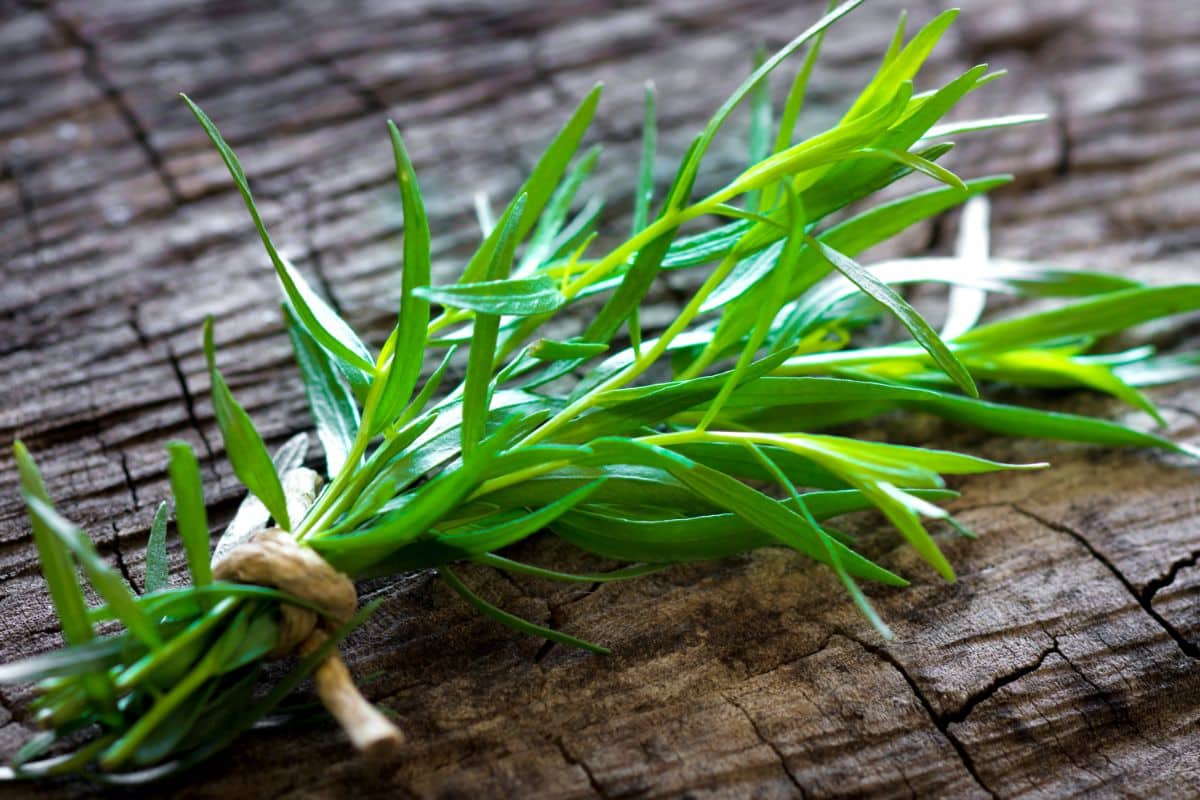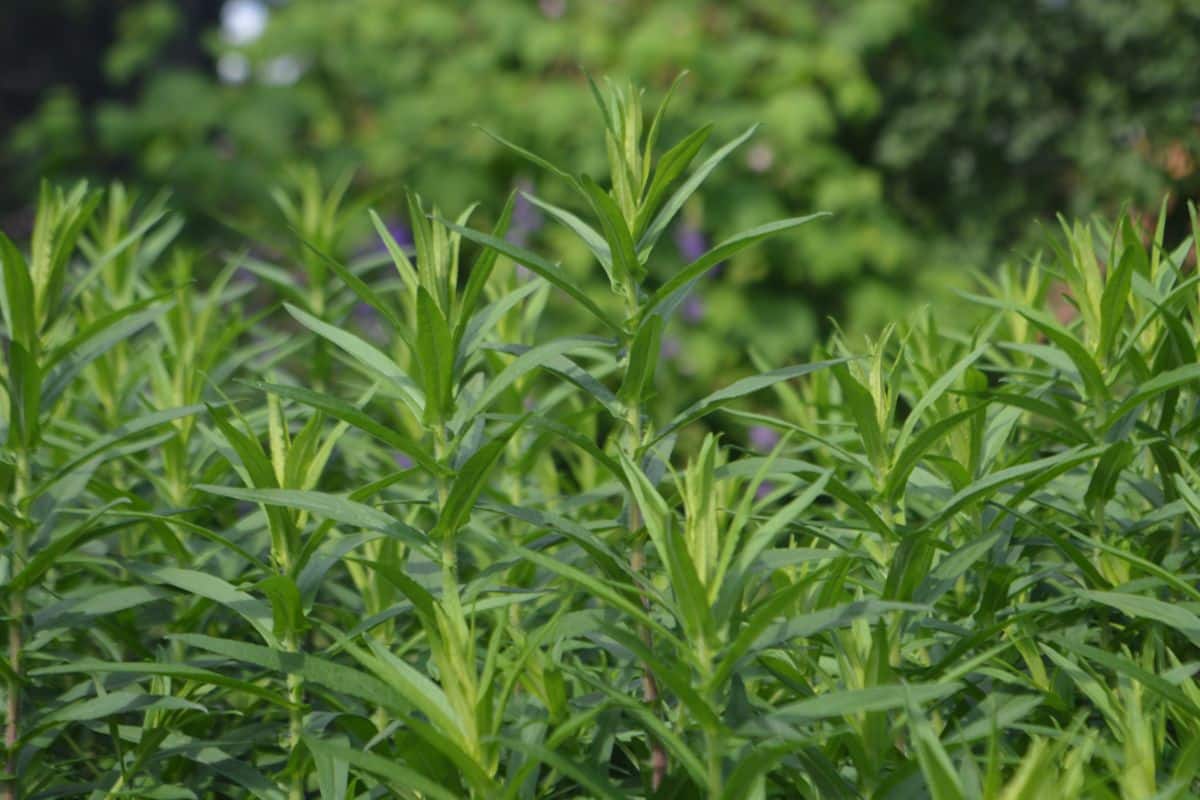Tarragon may not be the most popular herb out there, but there are so many ways to use it, there’s no reason why you shouldn’t be adding it to your pantry.

There are a few varieties of tarragon out there, and although they have similar flavors, each one brings something a little different to the table.
If you love the taste of licorice, you’ll love this distinctive, aromatic herb, and appreciate all the wonderful ways you can use it in your cooking! If you’ve never used tarragon in your dishes before, you’re probably not sure what to expect.
That’s why we’ve created the ultimate guide to tarragon to help introduce you to its flavor, health benefits, and cooking potential. We hope you’ll come away a tarragon lover, not a hater!
Without further adieu, here’s everything you need to know about tarragon, and how you can make the most of it in your cooking.
What Is Tarragon?
Tarragon is a type of perennial herb and a member of the sunflower family. Tarragon is a leafy green herb that’s often described as aromatic, and it has a slight licorice flavor.
Tarragon is versatile and fresh, and although it has a pretty intense flavor, it can be used to add a unique, fresh taste to your dishes, which can be described as a slight mix between aniseed and gentle vanilla.
Tarragon is a herbaceous perennial, and when it grows in the wild, it produces beautiful pink flowers. It usually reaches heights of around 2ft tall, and its oval leaves have a slightly rough texture.
Tarragon grows in many environments, including forests, roadsides, and gardens. It’s native to milder European climates, but it’s a notoriously hardy herb that grows well in sunny or shaded areas.
The Different Types Of Tarragon
There are three varieties of tarragon: Russian tarragon (or Artemisia dracunculoides), French tarragon (Artemisia dracunculus var), and Mexican tarragon (Tagetes lucida).
Russian Tarragon
Russian tarragon is a type of perennial herb and a member of the daisy family, that usually grows throughout southern and eastern Russia, as well as Mongolia, North America, and Afghanistan.
Russian tarragon often produces large, branching stems and aromatic foliage, with green and yellow flowers. This variety can grow up to three feet tall and can survive in both cold and hot climates.
French Tarragon
French tarragon is arguably the most popular variety of tarragon, and you may often hear it referred to as Estragon or the Dragon Plant. French tarragon is thought to have originated in western Asia, and it usually needs a warm, sunny, and sheltered area to thrive.
This variety of tarragon is not hardy and will need a greenhouse or sheltered porch to grow in over the winter. It also tends not to produce seeds or flowers too reliably, so it’s usually propagated for its cuttings or to divide the roots.
Mexican Tarragon
Mexican tarragon is a lesser-known variety of tarragon, and it tastes very similar to French tarragon, except it’s easier to grow. Mexican tarragon is much hardier than other varieties, and it can even thrive in climates susceptible to drought.
Mexican tarragon is native to both Mexico and Guatemala and like other varieties, it produces flavoursome, licorice leaves. However, Mexican tarragon often has detectable notes of mint and lemon in its leaves, which are not found in other varieties of tarragon.
What Does Tarragon Taste Like?
Most varieties of tarragon have a strong, licorice-like taste. In other varieties, this taste may be more subtle. Although licorice is the predominant flavor, it’s refreshing and spring-like, and some even report being able to detect slight hints of vanilla in the herb!
If you’ve ever tried fennel or anise, you’ll probably notice that tarragon has a very similar flavor.
The Health Benefits Of Tarragon
Tarragon doesn’t just taste good, it’s also good for your health! Adding tarragon to your diet is a great way to help manage your blood sugar levels, reduce inflammation and pain, improve sleep, and even benefit your heart health. Here are just a few of the benefits of adding tarragon to your diet.
May Relieve Pain And Inflammation
Tarragon is thought to help relieve pain and inflammation.
Tarragon has been used throughout the years to treat a number of ailments, including bites and dental pain, and researchers believe that the opioid receptors in the brain could have a part to play in tarragon’s pain-relieving effects.
However, most of this research has been performed on mice. More human research is required to determine its efficacy in pain relief.
May Help Regulate The Immune System
It’s also believed that consuming tarragon can help regulate the immune system.
Tarragon has some pretty powerful natural anti-inflammatory and immunomodulatory effects, that when tested on mice, showed a decrease in pro-inflammatory cytokines in the body after just 21 days of use. More human research is needed to support its benefits.
Could Help Manage Blood Sugar Levels

Tarragon may also help regulate blood sugar levels by decreasing blood sugar and improving the body’s sensitivity to insulin. In one study, Russian tarragon in particular was found to prevent insulin resistance and the accumulation of fat in the liver and muscle of mice.
May Improve Heart Health
Although more research is needed, some believe that tarragon may be beneficial for heart health. Tarragon is a popular ingredient in the Mediterranean diet, which has been proven to benefit heart health and even combat signs of ageing.
May Improve Sleep Quality
There’s also some evidence to suggest that tarragon can improve your sleep quality. Tarragon and other herbs belonging to the Artemisia family are often used to improve sleep, and evidence suggests that the herb has a natural sedative effect that can help promote and regulate better sleep.
How To Cook With Tarragon?
Tarragon is delicious, nutritious and incredibly versatile. It’s also one of the easiest herbs to cook with! There are plenty of ways to make use of tarragon in your cooking, including:
- In dressings
- In sauces
- In dips
You can use tarragon either fresh or dried, but most prefer to add it to their dishes toward the end of the cooking time to preserve flavor. Need some inspiration? Here are some popular dishes that lean on tarragon for their flavor:
- Creamy tarragon chicken
- Slow cooker chicken chasseur
- Tarragon lemon dip
- Sauteed tarragon radishes
- Herby pea salad
- Poached eggs with tarragon asparagus
You could also try using tarragon in the following ways:
- In sauteed shrimp
- Added to scrambled eggs or mashed potatoes
- Adding dried tarragon to a bechamel sauce
- Combine with garlic cloves and use it as a dip with bread
Does Tarragon Sauce Taste Like Tarragon?
Tarragon sauce is rich and creamy and pairs beautifully with a variety of dishes. Tarragon sauce is often white and it tastes pretty strongly of regular tarragon, with distinctive hints of licorice and anise dancing around the palette.
Tarragon sauce has a thick consistency that can be likened to mayonnaise, and it’s often used as a dip for some of our favorite foods including onion rings and french fries.
Tarragon sauce also pairs well with seafood, and you may see it added to dishes such as crab cakes to add an extra boost of flavor and texture.
How To Store Tarragon?
To make the most of your tarragon, you’ll need to store it correctly. Ideally, you should store your tarragon in an airtight container and place it in the refrigerator.
You should not attempt to dry out your tarragon, as this reduces the flavor. There are also a few other ways to preserve your tarragon, including:
- Freezing it
- Infusing it in oils
- Using it to make flavored butters, vinegars, and salts
Before you store your tarragon, be sure to follow these steps first:
- Inspect the leaves and stems of your tarragon, and remove any that are damaged or spoiled
- Once you’re sure which parts of the tarragon you want to save, gently wash it in running water to remove any dirt, debris, or chemicals. You may also prefer to soak your tarragon in a vinegar solution for a more effective clean
- Leave your leaves and stems to dry before storing them
If you’re planning to freeze your tarragon, follow these steps:
- Wash your tarragon in water to remove any dirt or debris, Leave it out to air dry thoroughly before freezing
- Strip the leaves from the stems
- Place your stripped tarragon into an airtight container and submerge in oil or water
- Now, you can store our tarragon in its container (or a bag) and place it in the freezer If you’re storing your tarragon in a bag, ensure you’ve removed any excess air first
- When you’re ready to use your frozen tarragon, you can simply add it into your food and allow it to thaw naturally as it cooks
It’s as simple as that! In just a few simple steps, you can have a vast supply of tarragon stored and ready to use when you need it. We highly recommend freezing your tarragon if you use it regularly, or need to cook up a storm when you’re short on time.
The Bottom Line
Tarragon is a pretty punchy herb with a unique flavor. It’s certainly not for everyone, but if you enjoy it, you’ll find an excuse to add it to almost anything.
Adding tarragon to your dish is a surefire way to introduce a fresh, uplifting dynamic to your food, and with so many ways to store and preserve it, it’s never been easier to transform your usual dishes into something a little fancier!
Just remember to thoroughly wash and dry your tarragon before storing it, and avoid drying it out if you want to preserve its flavor and freshness.






